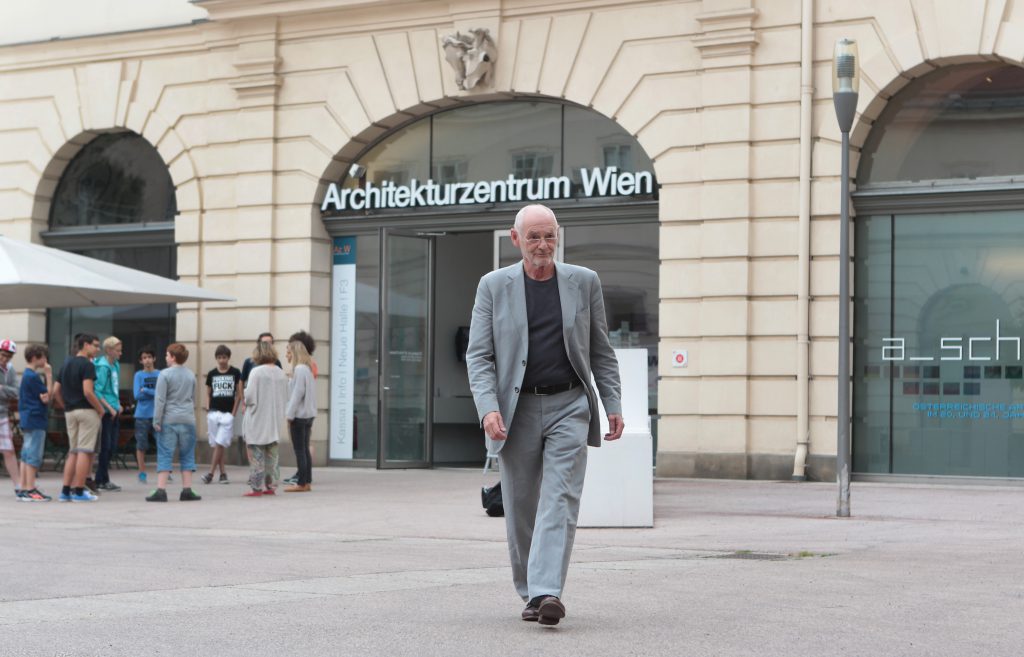
Dietmar Steiner
© Kurier, Franz Gruber
“Dietmar Steiner is forever bound to the successful first decades of the Architekturzentrum Wien. But not solely to the Az W, the architecture scene in Austria — and beyond — has lost one of their most committed representatives in Dietmar Steiner. He was never a conformist and his critical analyses always fuelled debate. But it is precisely these discussions, which he actively participated in, that have written architectural history.” Hannes Swoboda, President of the board of the Az W
“Dietmar Steiner gave the Az W its unique DNA, the envy of many museums today: being situated right in the midst of social debates. He has seismographically anticipated many current issues, from climate change to built solidarity. Architecture, and all of us who live in it have lost a great ally.” Angelika Fitz, Director of the Az W
“His energy, his passion and his contradictory spirit provided the basis for making the importance of contemporary architecture accessible to a broad public!” Karin Lux, Executive Director of the Az W
As an seismographic observer, a sharp-tongued critic and an uncompromising aficionado of architecture, Dietmar Steiner shaped the Austrian and international architectural world for decades. As an author for newspapers and for architecture magazines, as a lecturer, juror and curator, he had already established an international network before he became founding director of the Architekturzentrum Wien in 1993. He headed this institution, initiated by the City of Vienna and the federal government, for 23 years, making it one of the world’s most respected museums of architecture. The focus was always on the social dimension of architecture and the museum as a place for neuralgic debates”. Thus, with the first exhibition on the Rural Studio in 2003, he already brought an engagement with architecture involving radical, low-tech and low-cost approaches into the spotlight, initiating an international rethinking — especially in academic, media and theoretical circles. The Az W achieved a similar result with the exhibition on the hitherto unknown Soviet Modernism, which was to be followed years later by the major hype surrounding brutalist architecture. Other ground-breaking exhibitions under his directorship included ‘”Vienna. The Pearl of the Reich.” Planning for Hitler’, the first reappraisal of events in the building sector in Vienna during the Nazi era. ‘The Austrian Phenomenon’ or ‘Lessons from Bernard Rudofsky’ were devoted to the international reception of Austria’s architectural heritage, while projects such as ‘Chinaproduction’ and ‘Balkanology’ rendered the connections between global flows of capital and local contexts visible.
In his 23 years as Director of the Architekturzentrum Wien, Dietmar Steiner enlivened the Austrian architectural landscape with international topics, and Vienna’s urban development with controversial discussions. He established the Az W as an internationally highly regarded platform and an interface for the architectural community, and laid the foundation for the largest collection of architectural estates of Austrian architects of the 20th century. At the same time, the Az W developed into a museum for the general public with a broad educational programme, especially for children and young people — a pioneering role later adopted by many other architecture museums.
Dietmar Steiner, born in 1951 in Wels, studied architecture at the Academy of Fine Arts (first under Ernst A. Plischke, and then under Gustav Peichl). He collaborated on Friedrich Achleitner’s archive of Austrian architecture in the 20th century, taught at the University of Applied Arts until 1989 and served as Secretary General of the Austrian Society of Architecture (1980-1982). He also worked as editor of the international Milan-based magazine domus. In 2002, as commissioner, he curated the Austrian contribution to the Architecture Biennale in Venice. From 2006 to 2014 he was president of ICAM — the International Confederation of Architectural Museums. From 2009 to 2014 he was Chairman of the Quality Advisory Board for Social Housing in Vienna. From 1989 he ran his own architectural consulting office in Vienna. His lifelong activity on the interface between theory and practice, and the breadth of topics he covered predestined him for the role of a mediator. Whether between clients/investors and architects, between politics and the culture of building, between laypeople and experts, he was always concerned with addressing the background and interests involved, in shifting the framework conditions to ensure the best possible quality, especially for the users of architecture.
“Architecture is vital”, this conviction accompanied his decades of work for humane, sustainable architecture. In recent years, his view of architecture became increasingly pessimistic — he regarded large globally operating offices, star architects and the legal and economic undermining of the profession as symptoms of a social crisis. However he remained involved with architecture even after his retirement in 2017, and dedicated himself to an undertaking that had also marked the beginning of his career: the work of Friedrich Achleitner and the independent architectural guide to Lower Austria. Sadly, he was not able to see this project to its end.
Architecture has lost one of its greatest mentors. Our sympathy goes to his wife Margarethe Cufer. We shall miss him!
